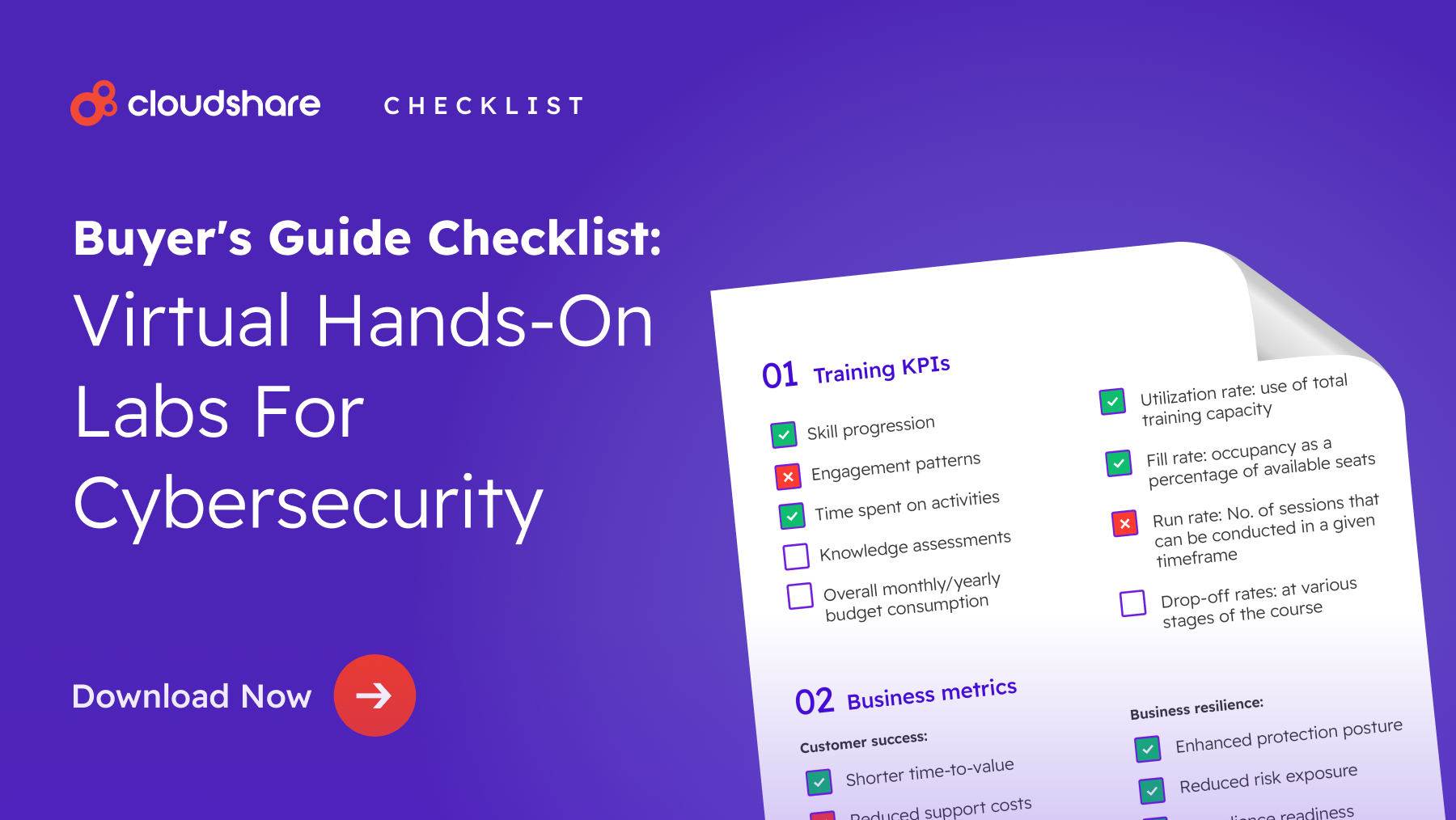
The impact of the coronavirus pandemic has been keenly felt in the training sector. The shift to a distributed workplace exponentially accelerated the timeline on digital transformation. In so doing, businesses were forced to adopt virtual training platforms for everything from customer onboarding to employee skill development.
The good news is that the benefits of this shift quickly became clear. Through virtual training, businesses could provide deeper, more engaging, and more personalized experiences. And by divorcing training sessions from the physical classroom, they enjoyed the added benefits of lower costs and more flexible scheduling.
It’s a transformation that couldn’t have come soon enough for the cyber security space.
A Troubling, Mercurial Threat Landscape
While businesses fall progressively further behind in their security training, threat actors have only become more numerous and sophisticated. And if current reports from analysts are any indication, things are about to get even worse. Ransomware is running rampant, zero-day vulnerabilities are popping up at an alarming rate, and supply chain attacks are at an all-time high.
Making matters worse is the rapid pace at which the cybercrime sector is evolving. Cybercriminals are constantly devising new exploits, attack vectors, and tactics. They’re constantly exploring new ways to perfect their shadowy craft, and they’re doing so too fast for our defenses to keep up.
Today’s criminal enterprises are a far cry from the black hat hackers of a decade ago. Many now function almost as dark mirrors of legitimate businesses, even going so far as to adopt sales tactics such as the software-as-a-service model. The prevalence of cryptocurrency only further sweetens the pot — cybercrime is now more profitable than many of the industries it targets, expected to cost the world $10.5 trillion by 2025.
In the face of this climate, hands-on cyber security training is a must — this is something virtual cyber security training labs are perfectly suited to provide.
The Power of the Cyber Security Training Lab
We’ve long been aware that traditional security education is broken. Passive learning only goes so far in fending off a cyberattack. Materials such as webinars and brochures offer knowledge without actually teaching people how that knowledge can be applied.
Security awareness training programs also rarely track progress, offer little context as to their importance, and frequently fail to follow-through to see if people actually learned anything. But how exactly does virtual cyber security simulation training address these problems? What advantages does a cloud cyber range offer compared to a traditional classroom?
Engagement and Retention
Ask any group of employees where their organization’s cybersecurity awareness training falls short, and you’re likely to receive one answer more than any other — it’s painfully boring.
Cumbersome walls of text filled with enough jargon that even a seasoned professional’s eyes glaze over. Drawn-out webinars and presentations that are more about ticking off a checklist than teaching. Pointless bulletins and memos that do little beyond languishing in employee inboxes.
To be blunt, this approach to training is a waste of everyone’s time. Make no mistake, well-written training materials and a comprehensive knowledge base are still crucial to your security posture. But if they’re not paired with opportunities for active learning, they might as well be grocery lists for all the good they’ll do.
With a virtual lab, you’re able to set up an immersive training environment that seamlessly pairs knowledge acquisition with hands-on learning. You give everyone an opportunity to learn by doing rather than seeing. This consequently goes a long way towards helping people outside your security team understand the pivotal role they play in protecting your business’s assets, thereby promoting an internal culture of cybersecurity.
A Focus on Feedback
Traditional cyber security training can be likened to flying blind through a thunderstorm. Instructors lack a consistent means of determining who’s struggling with their lessons and how. On the other side of the coin, employees receive little to no active feedback.
They might be aware that they’ve made a mistake, but they lack context for what said mistake actually means.
With simulated training environments, this is no longer an issue. Users are given sandboxes in which they can play, test, and learn without putting any systems or assets at risk. And when they do make a mistake, they’ll receive immediate feedback, giving them visibility into how their actions impact the wider organization.
It’s a learning environment that actually produces behavioral change, rather than one that expects people to adjust their actions based solely on information.
Instructors, meanwhile, can track progress through a wide set of different metrics. This allows them to proactively reach out with focused guidance to anyone who seems to be struggling. It also provides organizational leadership with a tangible idea of your training program’s level of success.
More importantly, however, is the fact that it provides you with invaluable insights into how your people engage with your business’s systems and technology. This can help you not only identify weaknesses with your training, but also in your organization’s overall security. You’ll gain a more complete picture of your security posture, and a deeper understanding of how and where you should direct your attention.
Risk-Free Sandboxing
Speaking of sandboxing, another core benefit of virtual training is that it allows security teams to hone their skills by mitigating simulated incidents. They can practice, experiment, and learn entirely at their own pace, without needing to waste time and resources scheduling a session with an instructor or booking a physical machine. This has applications beyond knowledge and skill development, as well.
A hands-on security training environment can also be used to identify potential risks and vulnerabilities in your infrastructure. Through simulated attacks, you can visualize and identify how real-world threat actors might exploit your organization in the real world. And that, in turn, allows you to take a more proactive approach to both cyber security and risk management.
Agile Education
We’ve already touched on the rapid pace at which cybercrime continues to evolve. Contending with such a fast-paced landscape of threat actors requires a flexible, streamlined approach to security education. Whether working with staff, partners, or customers, your business can no longer afford to waste time and resources painstakingly configuring environments for each individual use case.
And even a well-funded security team may have trouble tweaking and retooling simulations to address each emerging threat. These are non-issues with cloud training. Virtual training platforms can be effortlessly automated and easily configured to simulate any environment.
Better yet, they can be spun up from anywhere in moments and scaled to nearly any size. Because they’re so simple to manage and configure, this also allows security teams to create considerably more sophisticated content, even further empowering instructors.
In short, they take all the most prominent weaknesses of on-site cybersecurity training — scheduling, configuration, and transportation — and toss them out the window.
Low Overhead
Compared to on-premises training, cloud simulations are considerably more lightweight. With an on-premises solution, you need to manage everything. That includes, but is not limited to:
- Ensuring your network can support however many training instances are required.
- Managing and maintaining underlying hardware.
- Expending development resources configuring and integrating training software.
- Monitoring hardware and resource utilization to avoid over- or under-provisioning.
- Juggling lab bookings and training schedules.
- Paying out for both power and bandwidth required to run your training servers.
With a cloud platform, you simply configure, deploy, and you’re good to go.
How CloudShare Supports Cyber Security Training in a Post-COVID World
Now that we’ve touched on the benefits of virtual training labs for cybersecurity, let’s wrap things up with a brief overview of how CloudShare can provide your business with all of the above. Through our hands-on virtual cybersecurity labs, you can completely overhaul your security awareness training, replacing ineffective passive lessons with interactive, hands-on content. Our platform enables this in a few ways:
- Seamless Configuration. Leverage ready-made templates or create your own reusable environments and simulations which can be easily updated and reconfigured to address new tactics or threats.
- Sophisticated, Not Complex. Too often, training solutions force you to choose between simplicity and sophistication. With our specialized cloud, you no longer need to make that choice. We enable easy, intuitive training and configuration while also accommodating sophisticated, full-featured software and networks.
- Save Time and Resources. Spend more time teaching, and less time on scheduling and configuration. Pay only for what you use, and avoid overspending on underutilized systems.
- Multiple Training Options. Provide students with direct guidance through virtual instructor led training, or allow them to learn at their own pace in a self-directed training environment. Create more impactful training through multi-step classes, or support microlearning with tailored simulations.
- Infinite Scale. Through CloudShare’s powerful, reliable infrastructure, training sessions can be scaled instantly to support as many users as required, with no impact on performance.
Whether you’re helping trainees prepare for certification programs, educating customers on security best practices, or ensuring partners and vendors are up to organizational standards, CloudShare’s industry-leading cloud-based labs represent the perfect solution.
Keeping Pace With Cybercrime
The cyber security landscape is evolving at a breakneck pace, faster than at any other point in history. To say that it’s overwhelming would be putting it lightly — security teams across multiple industries and sectors are consistently struggling to keep up. Yet as we bring progressively more information, assets, and infrastructure online, it’s more important than ever that they can keep pace.
That starts with ensuring your employees are trained in the most effective, realistic, and up-to-date practices and principles of effective security. Because in spite of how much has changed about cyber security, there’s one thing that will always remain the same. Your people can represent either your best defense or your greatest risk.
Which camp they fall under is entirely up to you.



